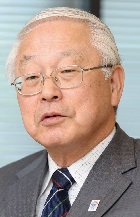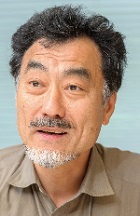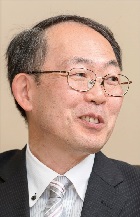IAC News
IAC News Extra.4, January 29,2014
Japan Society of Civil Engineers International Activities Center Jan 29, 2014 IAC News Extra.4
IAC News (Extra Issue.4)
<Roundtable Discussion>“What must be done for the Next Stage of Disaster Recovery?”Outcomes of the 2011 Great East Japan Earthquakecommemorative symposium |
Participants
|
Takehiko ONO |
Hitoshi IEDA |
Motoki KAZAMA |
|
100th President of the Japan Society of Civil Engineers (JSCE); |
Vice-Chair of JSCE (in charge of response to the Great East Japan Earthquake); Vice-Chair of JSCE Follow-up Committee for the Great East Japan Earthquake; Professor, Graduate School of Engineering, University of Tokyo |
Vice-Chair of JSCE Follow-up Committee for the Great East Japan Earthquake; Professor, Graduate School of Engineering, Tohoku University |
Moderator:
Yoh SASAKI, Chair of Editorial Committee, Journal of JSCE
Time and place:
Friday, April 19, 2013 in the JSCE Board Room (Titles as of April 19, 2-13)
| Sasaki: | In March 2013, JSCE held a four-day symposium entitled "Two Years After the Great East Japan Earthquake." Its program was packed with quite a lot of events. I would like to hear your views on the symposium's goals and results, along with a frank account of your impressions. |
| Kazama: | During the first two days, five sessions on general subjects were held from a comprehensive perspective. During the last two days, specialized issues were debated in sessions focused on individual topics such as nuclear energy, transportation, road reconstruction, and cleanup of radioactive contamination. As for my own impressions, although it was clear that a wide variety of issues are being addressed, I felt that more could have been said about how these efforts will ultimately contribute to the overall picture of recovery. |
| Ono: | Ever since I was installed as president of JSCE, the activities of JSCE have been aimed at achieving practical results in infrastructure improvement, instead of being limited to performing surveys and making recommendations. The subheading of the March symposium, "a prescription for full recovery of the disaster affected areas and renewal of Japan," reflected this intention. I believe that this symposium has been being addressed on the basis of this aim through activities and communications. However, this is not being addressed with the same level of intensity in all areas. We should have a stronger attitude of personal involvement as stakeholders with regard to the practical outcomes of our activities. Furthermore, although our respective activities take place in a wide variety of fields, I expect our members will mutually be aware of the importance of integration in our approaches to planning and fundamental technologies. |
|
Ieda: |
In terms of my own impressions of the symposium, I think the part that had the greatest impact on me was the special lecture by Junko Kumagai. It gave me a sense of the importance of focusing more on the real capabilities of many people such as Ms. Kumagai who are active as practitioners, instead of only giving our attention to leadership at the top levels. In Session 4, on the topic of achieving full recovery in the areas affected by the 3/11disaster, it was good to hear about studies based on various aspects of the actual conditions, as well as sincere views on challenges and areas where progress is being made. And in Sessions 7 through 11, participants overcame taboos in speaking out about various issues such as the earthquake and tsunami resistance of nuclear power plants, radioactive waste disposal, and the desired outcome for public transportation in the affected areas. That was not yet possible in last year's symposium, and I feel that this represents a large step forward in terms of future directions for JSCE. |
Need for a longer time span and less rigid deadlines
| Sasaki: | During the period since the disaster, there have been some issues of mismatched timing, such as communities that were unable to take some outstanding technical proposals into consideration because of time constraints. Now, two years out, the issues have become clearer and the climate is more conducive to debate. During the roundtable discussion in March, Dr. Kazama pointed out issues such as how to prioritize the challenges that need to be addressed. I would like to hear your views on how to approach specific issues such as this. |
| Kazama: | Initially, the local government organizations were all saying the same things in their recovery plans, mentioning a restoration period to be followed by a reconstruction period and then a development period, which were to be accomplished within time spans of two, five, and ten years, respectively. However, the fact is that there will be differences from community to community depending on how restoration and reconstruction are implemented and how long it takes for such measures to take effect. Considering the limiting factors, including shortages of materials and manpower, I believe that we need to think of these time periods with a little more flexibility and take a longer time horizon into consideration, while making clear distinctions among the different levels of priority. |
| Ono: | In the period immediately following the disaster, I think many government officials had a tendency to guess about the circumstances and needs of local residents. With the passing of time, we are now in a stage where the overall picture is being reviewed from a comprehensive standpoint and levels of priority are being differentiated. The government has strengthened the organization of the Reconstruction Agency, and that agency's efforts are being coordinated with those of the Ministry of the Environment, the Ministry of Land, Infrastructure, Transport and Tourism, and the Ministry of Agriculture, Forestry and Fisheries. I expect that this will have good results. |
| Ieda: | Until now, the emphasis among national, prefectural, and municipal governments as well as local residents has been to look at what may be achievable "right here and right now." As we enter the third year following the disaster, we need to begin addressing questions of what actually should be done in terms of a longer time horizon and a wider geographical scope, instead of only looking at what may be achievable. For this to happen, in addition to a sense of mission and passion, it will be necessary to need to engage in coolheaded debate with an attitude of rational objectivity. |
Commonly accepted values can hinder progress
| Sasaki: | As we attempt to move ahead with a rational and objective approach, the basis for such debate is formed by a framework of laws and standards that were put in place at a time when no one had anticipated a disaster of this nature. The struggles, contradictions, and uncertainties of the affected areas come into play when we try to resolve the current problems within the existing framework. The fact is that some changes may be needed in the structure of this framework. |
| Kazama: | There have been cases of applying the existing framework with flexibility. For example, just recently in the expropriation of land along the coast of Iwate Prefecture, it has been reported that greater flexibility was introduced in land acquisition by eminent domain. This has made it possible to expropriate land in cases where the landowner is unknown and it would be impossible to obtain the landowner's consent. |
| Ono: | It has been pointed out that organization barriers can be an obstacle to the resolution when multiple government agencies are involved. I hope this is greatly highlighted and will be improved in a near future. |
| Ieda: | During the past two years, many limitations have arisen as a result of the characteristics of institutions and organizations, and I think that the values and principles underlying them have played a significant role. For example, some difficulties have resulted from the fundamental notion that decentralization of authority is always the best approach. Even when residents call on their local governments to make a decision, the local government may be unable to do so on its own and would prefer to have standards developed by the national government. However, the national government hesitates to dictate standards because of this value that is placed on decentralization of authority. I have seen many cases where this has led to an extremely time-consuming process of delays and reworking. Decentralization of authority is important, but I think we can accept the idea that in a crisis situation, it may be necessary to switch from the decentralized mode of ordinary times to an emergency mode with greater centralization of authority. |
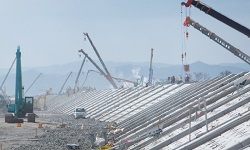 |
In a coastal area of southern Sendai, work is underway on the reconstruction of sea embankments. (Photo taken in March 2013; provided by the Kanto Regional Development Bureau.) |
Concern about diminished capabilities for comprehensive management
| Ieda: | On the other hand, it is fine for a local area to express its own unique values in relation to decisions like the construction methods and heights of tide embankments, or the approach to locating urban areas, for example. I believe in letting each locality act in a manner that reflects its own characteristics and values, with diversity instead of uniformity. |
| Kazama: | That's fine if the decision goes in a direction that is more economical, but it is hard to get approval when one area insists on getting higher-grade improvements than other areas. There are budgetary limits as to how high an embankment can be raised. Also, because the funds for reconstruction come out of tax revenues, I think citizens should have some voice in urban planning decisions even if they will not be directly affected; however, it seems that interference from outsiders is not always welcome. |
| Ieda: | My view is that no matter what the situation, the best answers are reached when the opposing parties can argue it out together. For that to work, the local communities need to have strong enough willpower to engage in debate, and the national government needs to check on whether the measures are really necessary and make any necessary cuts. That is also its duty to taxpayers. |
| Ono: | A variety of new ways to build infrastructure are now being tried out, including public-private-partnerships and new construction management methods. I expect that these ways will be successful and contribute to the future infrastructure development. There are downsides when organizations in charge of infrastructure development become excessively specialized. However, the approaches taken this time are expected to contribute to the total comprehensive management skills. I think the present biggest problem is the decline of comprehensive management capabilities. |
Recovery work provides civil engineers with opportunities for growth
| Sasaki: | It may be said that civil engineering for public works incorporates all of the various areas of engineering. In the symposium, in relation to the problems of radioactive waste disposal, high expectations were indicated for comprehensive management capabilities among civil engineers who know about issues in the field, understand the work methods, and are capable of analysis based on a multidisciplinary approach. How, specifically, should leadership be provided? Is there a role to be played by JSCE? |
| Ieda: | In civil engineering, along with the breadth of the scope it covers in terms of fields, time, and space, the most important point is the level of comprehensiveness and integration that must be achieved. How should the civil engineer unify all of this? One could take the old-fashioned view that the civil engineer should be a strong "leader among leaders," but the idea of simply giving orders is not suited to the times. Instead, we civil engineers need to play a coordinating role, while other experts specializing in various fields do their part and contribute their answers for us to combine. The key to our work as civil engineers is that we are the glue that holds it all together. That is the significance of our role in comprehensive management, as the chairman was saying. Now that we are faced with needs for reconstruction in the affected areas, we have the opportunity to improve our own abilities and develop a true capacity for comprehensive management. I feel that this can be an occasion for growth among civil engineers. |
| Ono: | In addition, there are many other challenges to be faced in a disaster-prone country like Japan. Capacity building can also be achieved through efforts to prepare for anticipated earthquakes including Nankai and Tonankai earthquakes and a "direct-hit" earthquake under Tokyo. |
Expectations for the recycling function of civil engineering
| Sasaki: | Two years after the earthquake, we can take the opportunity to reflect and consider the many tasks that lie ahead. How do you believe our efforts should be directed in the future? Also, what message would you like to send to the members of JSCE? |
| Kazama: | It is said that the infrastructure of Japan has entered a maintenance era. For recovery in a society where the population is shrinking, it is important to consider issues of maintenance, starting at the time of construction. In addition, in the sense of breaking down existing structures to build new ones, I think that civil engineering has an important function in recycling the wastes of the disaster, similar to the role played by the venous portion of the body's circulatory system. Rubble and toxic substances can be reused as resources in cement and other materials. The generation of waste is an unavoidable part of our activities. Although the Ministry of the Environment has established requirements concerning the level of environmental conservation, that can only become a reality through the work of civil engineering. For example, the processing of contaminated water is dependent on the technology of the final disposal site; and only the field of civil engineering can actively address the issues related to intermediate storage facilities. Young engineers and researchers are becoming involved in these fields, and there is a renewed awareness of the importance of this kind of work. |
| Ieda: | A variety of ad hoc committees have been established to work in limited scopes. These have been active in the area of regional infrastructure reconstruction, especially in cooperation with the City Planning Institute of Japan (CPIJ), and such efforts will continue in relation to the requests of CPIJ, the nuclear accident in Fukushima Prefecture, and the recovery of areas affected by the disaster. Similarly, work has only just begun in relation to civil engineering technologies for radioactive waste, and this will also be ongoing. In other areas, ad hoc committees have already achieved a certain level of results, and their work will be transferred to standing committees. |
| Ono: | It is best for works on elemental and fundamental technologies to be transferred to standing committees as far as possible. In addition, I hope that regional branch members will reconsider how the latest recommendations should be applied in their regions. I expect the platform for liaison among branch organizations play an important role. There have been failures such as the case of Sasago Tunnel on Central Nippon Expressway. Our branch members have considered how to maintain the infrastructures that they have constructed from various viewpoints over the past two years. I expect our members take a stakeholder perspective and take actions vigorously towards solving these issues. |
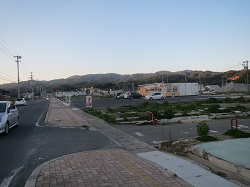 |
Scene in the Shikaori district of Kesennuma, Miyagi Prefecture (May 2013, photo credit: Kuroyama, editorial committee member) |
Edited by: Fumio Komazaki
Photos: Masao Nagata
(This is an English translations from the Japanese version published in JSCE Journal, Vol. 98, No. 9, September 2013)
What's Happening
Updates
・The summary of feature articles in the JSCE Magazine is available on the JSCE website.
(http://www.jsce-int.org/pub/magazine)
・Concrete Committee International Newsletter No. 35
(http://www.jsce.or.jp/committee/concrete/e/newsletter/Newsletter.htm)
IAC News Subscription
IAC publishes the IAC News as one of tool to communicate with and share information with the members. In order to network widely, we would like to invite you, your friends and colleagues to become a subscriber to the IAC News. Please register online if you are interested in the IAC News: (http://committees.jsce.or.jp/s_iad/iac_news_e). We are looking forward to meeting you.
Registration form for IAC News subscription:
・Japanese :(http://committees.jsce.or.jp/kokusai/node/31)
・English :(http://www.jsce-int.org/pub/registration/non-international_students)
・English for those who have studied/ graduated from Japanese colleges and universities :
(http://committees.jsce.or.jp/kokusai/node/30)
【Comments and Questions】
Please send us your feedback and comments to help us improve the IAC news. We look forward to hearing from you.
JSCE IAC: iac-news@jsce.or.jp

